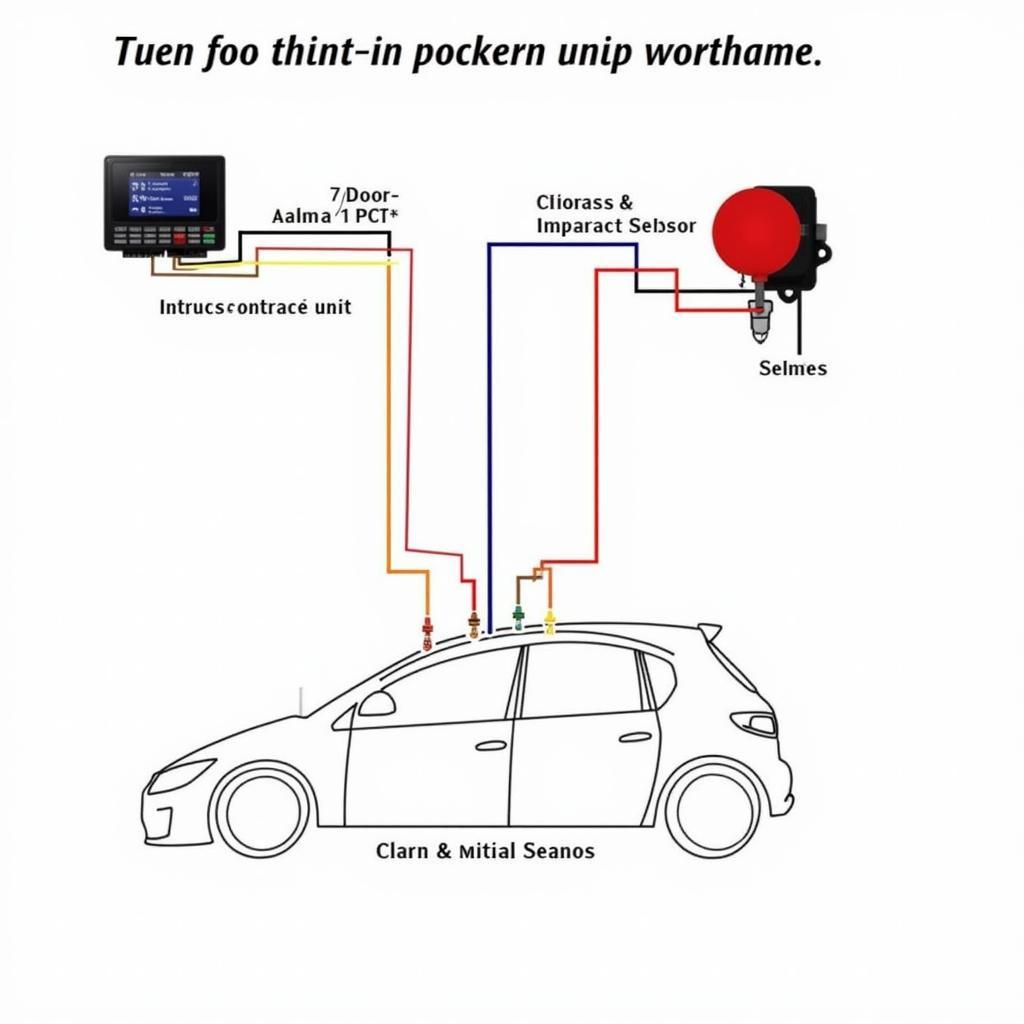Understanding car alarm and remote start wiring can be daunting. This comprehensive guide breaks down the intricacies of these systems, providing valuable insights for both DIY enthusiasts and those seeking professional installations. We’ll explore everything from basic wiring diagrams to advanced troubleshooting techniques, ensuring you have the knowledge to tackle any car alarm or remote start project.
Decoding the Basics of Car Alarm Wiring
A car alarm system is essentially a network of interconnected components designed to deter theft. At its core, the system comprises a control unit (the brain), sensors (the eyes and ears), a siren (the voice), and a remote (the command center). Understanding how these components communicate through wiring is crucial for successful installation and troubleshooting.
The control unit receives signals from the sensors, such as door triggers, impact detectors, and motion sensors. These signals travel through wires, activating the siren and potentially other features like flashing lights or starter disable. The remote, through radio frequency signals, allows you to arm and disarm the system, controlling the flow of electricity through the wiring harness.
 Car Alarm Basic Wiring Diagram
Car Alarm Basic Wiring Diagram
Understanding Remote Start Wiring: Adding Convenience and Comfort
Remote start systems add a layer of convenience by allowing you to start your car from a distance. These systems integrate with your vehicle’s ignition system, requiring a more complex wiring setup than a basic car alarm. The remote start module intercepts the ignition signal, mimicking the action of turning the key.
The wiring for a remote start system involves connections to the ignition switch, starter motor, and various other components depending on the specific vehicle and system features. Proper wiring is crucial to ensure the system functions correctly and safely.
Troubleshooting Common Wiring Issues: A Practical Guide
Wiring problems are a common source of frustration with car alarm and remote start systems. Symptoms like a malfunctioning alarm, a non-responsive remote, or a failed remote start can often be traced back to wiring issues. A multimeter is an invaluable tool for diagnosing these problems.
By testing the continuity of the wires and checking for voltage drops, you can pinpoint the source of the issue. Common problems include broken wires, loose connections, and corroded terminals. A systematic approach to troubleshooting, starting with the basics and progressing to more complex checks, is essential.
Integrating Car Alarm and Remote Start: Streamlining Your Security and Comfort
Combining a car alarm and remote start into a single system offers both security and convenience. These integrated systems often share wiring and components, streamlining the installation process. The control unit acts as the central hub, managing both the alarm and remote start functions.
Professional Installation vs. DIY: Weighing Your Options
While a DIY installation can save money, it requires a good understanding of automotive wiring and electronics. Professional installation ensures the system is wired correctly and integrated seamlessly with your vehicle’s electrical system. A professional installer can also diagnose and resolve any pre-existing wiring issues that might interfere with the system’s performance.
Conclusion: Mastering Car Alarm and Remote Start Wiring
Understanding car alarm and remote start wiring is crucial for successful installation and troubleshooting. Whether you choose a DIY approach or opt for professional installation, this guide provides the knowledge you need to navigate the complexities of these systems. Mastering these wiring details ensures your vehicle’s security and enhances your driving experience with the added convenience of remote start.
FAQ
- What gauge wire should I use for car alarm installation? Generally, 18-gauge wire is suitable for most car alarm installations.
- Where can I find a wiring diagram for my specific vehicle? Vehicle-specific wiring diagrams can often be found in repair manuals or online resources.
- How do I test the siren of my car alarm? You can typically test the siren by briefly triggering the alarm system.
- What is the range of a typical remote start system? Remote start range varies depending on the system, but it typically falls between 500 and 1500 feet.
- Can I install a remote start system in a manual transmission vehicle? Yes, but it requires additional safety features like a neutral safety switch.
- What should I do if my remote start stops working? Check the battery in the remote, and if that’s not the issue, consult a professional installer.
- How do I choose the right car alarm and remote start system for my vehicle? Consider your security needs, desired features, and budget when selecting a system.
Common Scenarios and Questions:
Scenario 1: Alarm goes off randomly. This can be caused by a faulty sensor, a low battery in the remote, or a wiring issue.
Scenario 2: Remote start doesn’t work. Check the remote battery, the vehicle’s battery, and ensure the vehicle is in park (or neutral for manual transmissions).
Scenario 3: Siren doesn’t sound when alarm is triggered. This could indicate a problem with the siren itself, the wiring to the siren, or the control unit.
Further Resources:
- Explore our articles on car security systems and remote start technology.
- Check out our guides on car audio and electronics installation.
For any assistance, please contact us via WhatsApp: +1(641)206-8880, Email: [email protected]. We have a 24/7 customer support team.

Leave a Reply